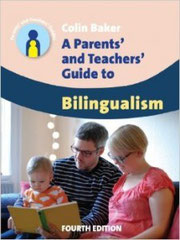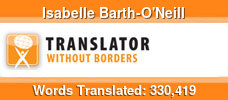Critiques de livres / Books reviews

I just finished the book "Bilingual Childcare – Hitches, Hurdles and Hopes" by Victoria Benz. I must say that I really enjoyed it. It is a fascinating in-depth study, an ethnographic study, of an early childhood dual language programme in Australia. The book is full of information, complemented with people's points of view when the author quotes the parents she met and interviewed. Victoria Benz has been investigating a German-English childcare centre in Sydney, Australia. She tells us about what she discovered and surprised her most. After exploring at the manner, it was established and implemented, she examines what is happening. She first looked at how the carers or teachers as they are often called are managing the two languages, German and English in the everyday routine of the children. Which language is more predominant and why? She spent time looking at the attitudes of the educators as well as their ideologies and practices, asking them why they were acting in such a manner. She discovered a number of facts which are quite surprising and explain why there is such an asymmetry between these two languages. She then queried their training and backgrounds as bilingual carers or teachers and discovered there are a number of discrepancies in the Australian system.
She also took time to survey the parents who sent their children to the centre she chose to call Fritzkids. Why did they choose that centre? Is it because of the languages or for any other reasons? She also looked at their attitudes, ideologies and practices outside the day care. Their answers are sometime quite surprising and I myself, as a bilingual language advisor, was quite surprised. The background of the parents is also reviewed as well as what they intend to do with the German their children had acquired. What is the value that parents are giving to the bilingual education and to the languages in this case. There is a kind of complex relationship between the childcare provider and the clientele which helps to understand what is really. The external constraints seem to be against the success of bilingual education and would have an influence on the language policy at family, institutional and state levels.
Victoria Benz concludes with a look at the future of bilingual education for young children. The attitude of the parents, the training of the teachers, the country language policy, the family language policy, all of these elements will influence the development of any bilingual childcare.
Although Victoria Benz has been studying on specific childcare in Australia, I feel that her findings could be applied to many other bilingual childcares and that anybody wishing to run such a childcare should be reading this book and see how they can improve what they are doing, what they are offering, how they are offering it. It gives light on language ideology vs the practicalities of life. This book would also be of great interest to teachers who are training and looking at bilingual education. It is well researched and gives a new perspective on bilingual education in monolingual society.
(May 3rd, 2018)

Family Language Learning - Learn Another Language, Raise Bilingual Children by Christine Jernigan (owner of BilingualWiki) is a different type of a book. It is extremely interesting and I enjoyed it myself immensely.
Christine Jernigan says it in her introduction: It is not a book for bilingual parenting. So what is it then? It is a book for "people who are still learning a second language they want to impart
to their children" (page ix). So it is for parents who are themselves learning a foreign language and are wishing to pass it on to their children.
The author is very much interested in presenting how you can raise your children with a foreign language that you are yourself in the process of learning - which she did herself with her own children raising them in English and Portuguese). Her book is for parents who did not grow up speaking two languages. It is also aimed at "native speaker of one language (…) living in a country with a different majority language" (page x), as well as those wishing "to raise your child bilingually… through immersion programs… a nanny who speaks the second language…. home-schooling parents...
Although Christine Jernigan is an academic, she writes in a non-academic manner. The book is full of examples, full of tips. She takes from families she has been talking to. She talks about success, but also failure. It is a very easy book to read and does not have to be read from beginning to end, it is not a "textbook"(page xiii). She points out one disadvantage that mixed marriages do have which is : "If you are a non-native speaker… you may feel at a disadvantage (…) Non-native parents might (…) feel behind culturally. They know the right words, but not the right customs behind what they are saying." (page 150). It is often said that language and culture make one and that you cannot have a language without the culture where it is spoken. It is sure that Christine Jernigan is a great advocate of raising children with more than one language at home, even though she knows it will be the language without the culture attached to it.
I would recommend this book to all parents who are choosing to raise their children with more than one language at home especially when they are not native speakers of that language.
(16 February 2015)
Colin Baker's "A Parents' and Teachers' Guide to Bilingualism"

"What are the advantages of my child becomin bilingual?" This is one of the many questions to which the Guide : A Parents and Teachers Guide to Bilingualism Guide tries to answer.
Presented in a very handy manner of questions and answers, this guide is certainly one of "must-have" to answer many of the worries and concerns we might have in trying to raise our children in a bilingual manner.
Each of the five mains sections is answering a different view such as the language development, reading ans writng, or even education. Each section answering a number of questions each of us may have. No topic seems to have been left behind as question such as dyslexia, autism and bilingualism are also answered in a very clear manner.
Colin Baker's Guide is a useful reference book for every family who wishes to enter the road of bilingualism.
It is very handy to use. It does not have to be read like any other books as you can go from one question to another one in the order you like. At the end, you will find a very handy glossary with many terms and heir exact definition.
It is a book every bilingual family should have in their bookshelf.
I would also say that it is also a Guide that any teacher who has bilingual children is his ou her class should have as teaching bilingual children could be a real challenge for them.
I wish to thank the publisher for asking me to review this Guide and I am delighted to say that, even though I knew most of the answers given, i am delighted to have done it. I wish everyone to enjoy this Guide as much as I do and I would recommend it to anyone who wished to raise bilingual children.
(19 May 2014)

I have just read the book “New Perspectives on Translanguaging and Education”, edited by BethAnne Paulsrud, Jenny Rosén, Boglárka Straszer and Åsa Wedin (Multilingual Matters – Bilingual Education and Bilingualism: 108, 2017). This book is absolutely fascinating and I would highly recommend it to any person who is working with bilingual children whether in a crèche, a primary school, a secondary school or any other educational groups and/or associations welcoming bilinguals. It gives a new light on translanguaging with examples from the English-speaking world and Scandinavian countries mostly. Those can be applied anywhere.
Divided in 13 chapters, plus an epilogue, this book explains the advantages of learning and teaching using translanguaging, mostly in local situations where the monolingual model is very important. Each chapter, written by various lecturer, researchers and university Professors, looks deeply into the experiences of different level of education, different systems and different countries. We get a really in-depth view of how translanguaging can work to help the learners use all their language abilities. It is quite interesting to see how language and languaging are being described and use. Languaging being the ability to use all the manner you have to express yourself, whereas languages are seen as different tools, as a resource to language yourself.
Translanguaging is seen as a new way to challenge the monolingual educational systems. For example, Jenny Rosén looks at translanguaging in the Swedish education policy where, even if the country is having a minority speaking Sami, the Swedish language is still prominent in the curriculum and teachers are like soldiers following the “orders” they are given. In another chapter, Latisha Mary and Andrea S. Young are studying how translanguaging helps the young migrant or bilingual children to enter pre-school in monolingual country. Children feels then safe. Translanguaging creates a social space for those children to feel confident. The teacher is then acknowledging the children’s linguistic knowledge and skills. It is contrary to immersion.
Many teachers do not have training on how to support children who speak other languages and the translanguaging method allows them to bridge between the distance which could be there in terms of languaging. Kirsten Rosiers sees translanguaging as a scaffold among teachers and pupils. The many examples she gives in her chapter are really helping to understand her views. Anna Slotte and Maria Ahlholm are looking at the role of translanguaging to acquire concepts. As a pedagogy, translanguaging is opening new doors, and we should look at language ecologies to be able to use it better. Translanguaging is not putting hierarchy on languages, looking at languaging rather than languages. It is a great tool.
It is difficult for me to summarise every single chapter as it would really be too long of a review.
I warmly recommend to any person who has bilingual children or children using another language at home to read this book. It is an eye opener, with many ideas, examples and concepts.
PS: I am holding workshops on translanguaging – Multilingual Matters will offer a discount on some of their books to those attending them. More info at: lamaisondumultilinguisme@gmail.com or multilingualcafe@gmail.com
La Maison du Multilinguisme
Nous sommes un organisme de formation ouvert sur le monde professionnel, social et culturel.
Notre formatrice s'appuie sur vos besoins et vos envies pour construire des formations qui vous ressemblent.
Elle se tient au fait des nouvelles recherches dans le domaine du bilinguisme, multilinguisme et plurilinguisme.
nº d'enregistrement : 32 62 03215 62









